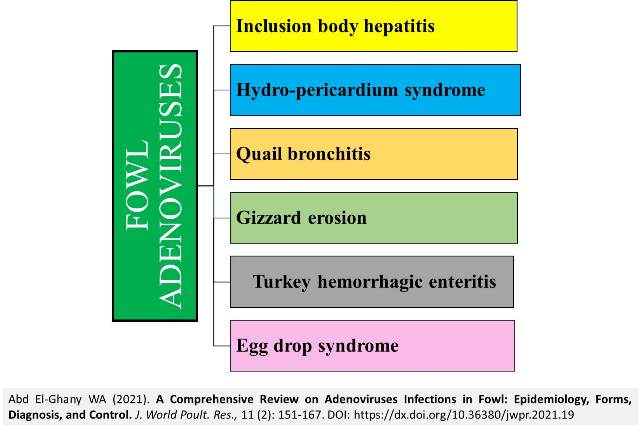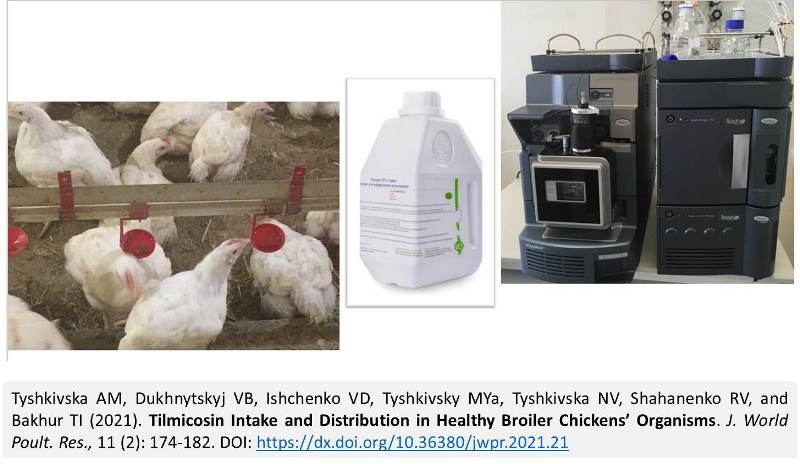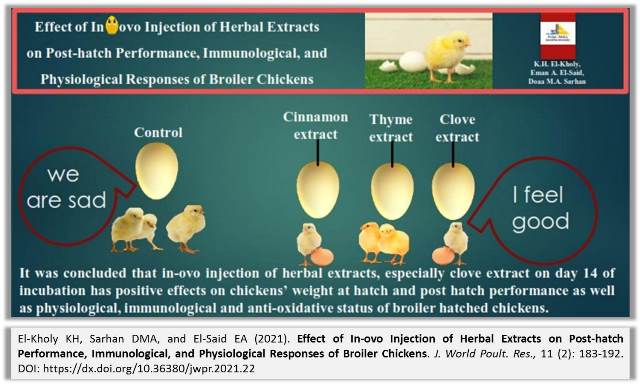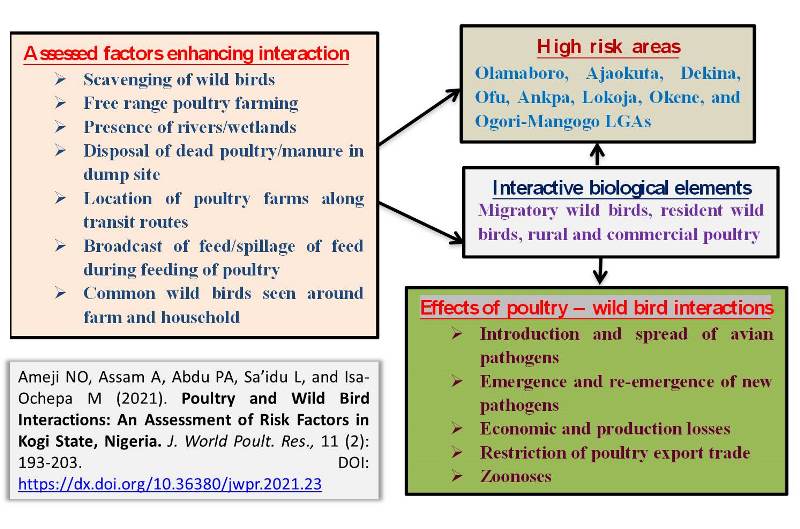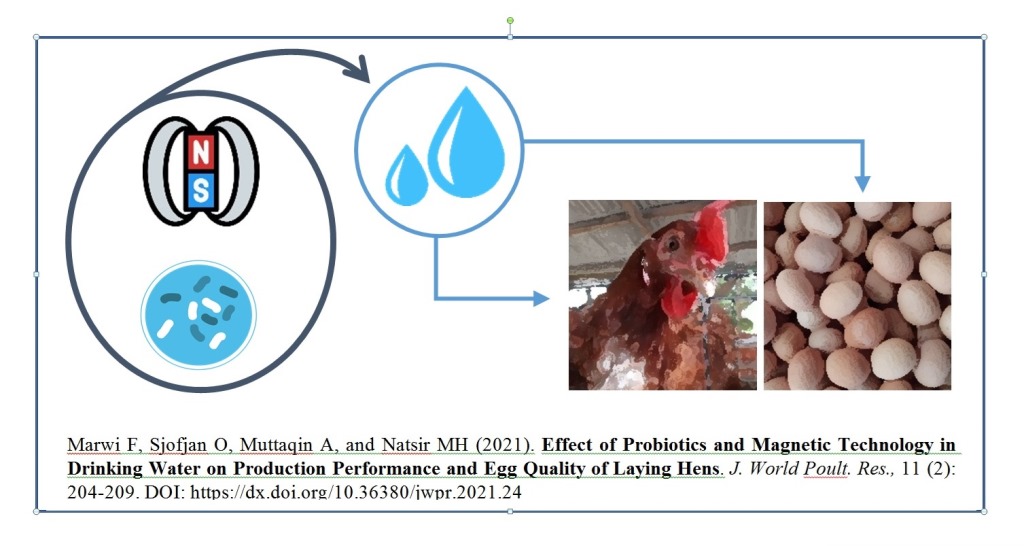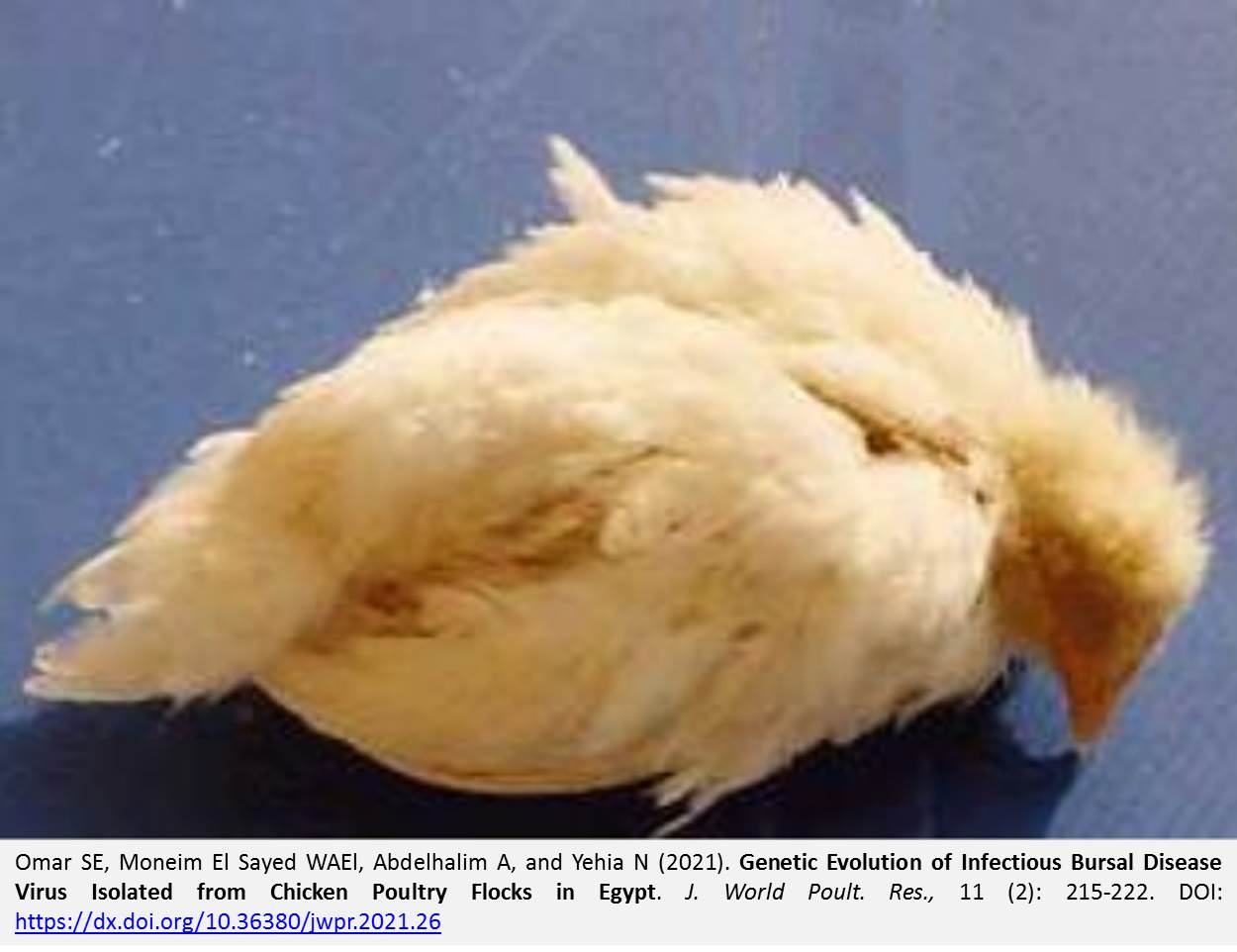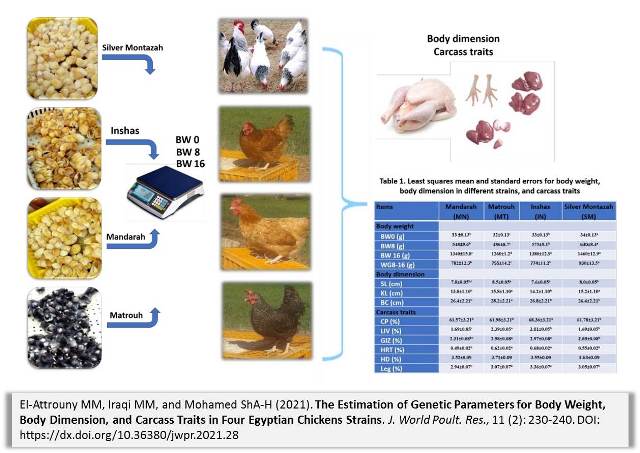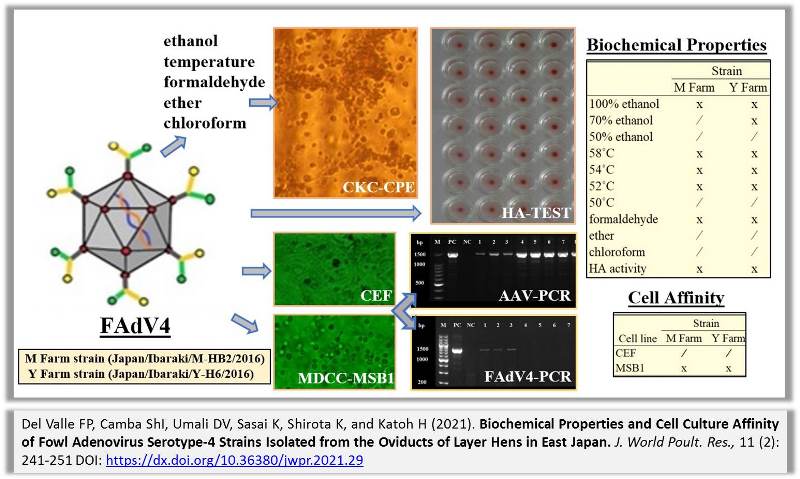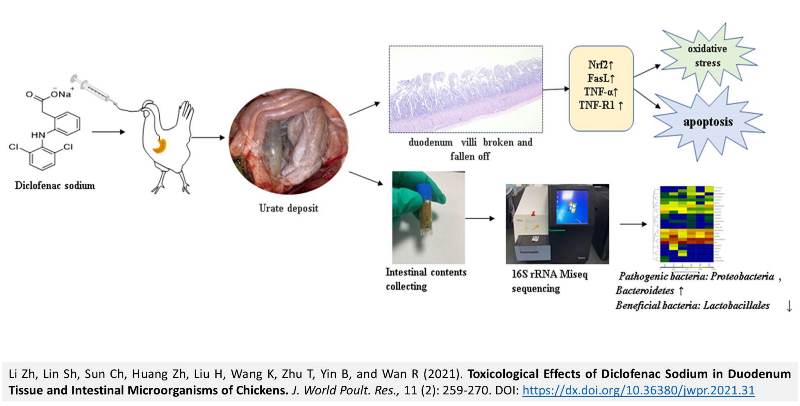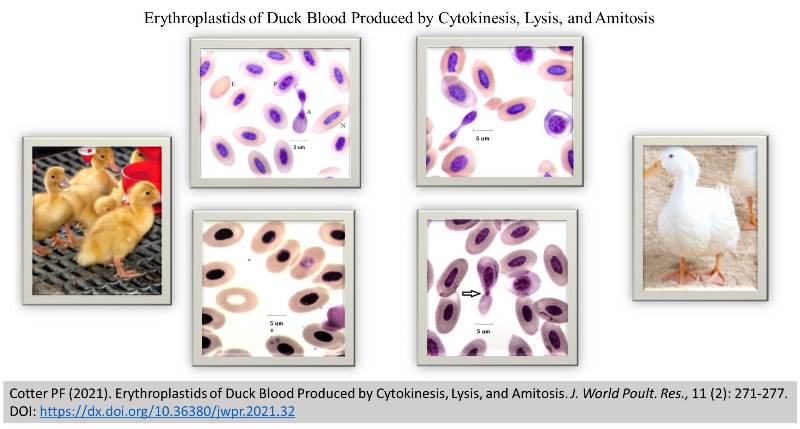Previous issue | Next issue | Archive
Volume 11 (2); June 25, 2021 [Booklet] [EndNote XML for Agris]
|
|
Review
A Comprehensive Review on Adenoviruses Infections in Fowl: Epidemiology, Forms, Diagnosis, and Control
Abd El-Ghany WA.
|
|
J. World Poult. Res. 11(2): 151-167, 2021; pii: S2322455X2100019-11
DOI: https://dx.doi.org/10.36380/jwpr.2021.19
ABSTRACT: Fowl Adeno Viruses (FAdVs) are non-enveloped and double-stranded DNA viruses. They include eight species (FAdVs A-E) and 12 serotypes (FAdVs-1 to -8a and -8b to -11). Strains of FAdVs have been widely distributed in different countries all over the world. Most avian species are susceptible to FAdVs infections. Vertical, horizontal, and mechanical infections and transmissions have been recorded in different forms of FAdVs infection. There are many forms of FAdVs infections according to the groups (including three groups) of the virus. Group 1 usually causes inclusion body hepatitis, hydropericardium syndrome, quail bronchitis, pancreatic erosions, gizzard erosion, cardiovascular, hematopoietic, and respiratory systems disorders. Group II is incriminated in diseases, such as turkey hemorrhagic enteritis, marble spleen disease in pheasants, and splenomegaly in chickens. In addition, group III is responsible for egg drop syndrome in laying chickens. Diagnosis of FAdVs infections is not based on the signs and lesions. However, microscopic detection of specific lesions and inclusion bodies may be suggestive. Diagnosis is mainly based on the conventional traditional isolation in embryonated eggs of different avian species as well as on tissue culture of avian origin. Molecular diagnostic techniques are now widely used for rapid and confirmative detection of FAdVs. The application of sanitary and hygienic measures in poultry farms is very important to prevent FAdVs outbreaks. However, different types of inactivated, living attenuated as well as recombinant vaccines have been developed and used in several countries to overcome different forms of FAdVs. Therefore, this review article deals with the FAdVs susceptibility and transmission, the etiological agent, forms of infections, and diagnosis as well as different methods of prevention and control.
Keywords: Egg drop syndrome, Fowl adenoviruses, Hydropericardium syndrome, Inclusion body hepatitis, Quail bronchitis, Turkey hemorrhagic enteritis.
[Full text-PDF] [XML] [Crossref Metadata] [How to Cite]
|
|
Research Paper
Effect of Lysolecithin Supplementation to Low-energy Broiler Diets on Performance and Subsequent Cost-benefit Analysis
Ghazalah AA, Abd-Elsamee MO, Ibrahim MM, Gonzalez-Sanchez D, Wealleans AL, and Abdelkader M.
|
|
J. World Poult. Res. 11(2): 168-173, 2021; pii: S2322455X2100020-11
DOI: https://dx.doi.org/10.36380/jwpr.2021.20
ABSTRACT: The use of lysolecithin as an emulsifier in the diet of chickens could improve the growth performance. Its commercial application in broiler diets containing medium to high levels of added oil is increasingly adopted. However, few studies have assessed the impact of lysolecithin supplementation in diets formulated with no added oil. Therefore, this study aimed to compare two feeding diets based on commercial low-energy diets with no added oil, with or without a nutrient absorption enhancer based on lysolecithin (LEX). The performance was recorded on days 7, 14, 21, and 28. The net benefit per chicken of LEX supplementation was determined across a range of cost and performance scenarios. At slaughter, average body weight and feed conversion ratio were significantly improved in LEX-treated chickens, compared to non-treated chickens. The net benefit per chicken of LEX supplementation was €0.023 under representative market conditions and remained profitable under all considered scenarios. In conclusion, the application of absorption enhancers based on lysolecithin could improve the performance and profitability of broiler production, even in low energy-dense diets formulated with no added oil.
Keywords: Broilers, Cost-Benefit, Economics, Lysolecithin, Performance
[Full text-PDF] [XML] [Crossref Metadata] [Scopus ID: 85110491379] [Export from ePrint] [How to Cite]
Research Paper
Tilmicosin Intake and Distribution in Healthy Broiler Chickens’ Organisms
J. World Poult. Res. 11(2): 174-182, 2021; pii: S2322455X2100021-11
DOI: https://dx.doi.org/10.36380/jwpr.2021.21
|
|
ABSTRACT: Detection of the time required to reach the maximum concentration in the organs promotes better prediction of antibiotics activity for the treatment of infectious diseases in broiler chickens. The current article presented the research results of the intake, distribution, and elimination of the antibiotic Tilmox 25% (the active ingredient is tilmicosin phosphate (TPh)) from the body of healthy broiler chickens (cross COBB-500) during oral administration. The findings of the current study indicated the rapid absorption of TPh from the digestive tract of a fowl and its intake into the internal organs. The maximum TPh content was observed in the lungs and liver 2 hours after the start of the Tilmox solution using which amounted to 17.02 ± 0.24 and 12.78 ± 0.22 µg/g, respectively. The maximum values of 8.25 ± 0.19μg/g were recorded for the kidneys after 26 hours, and for the pectoral muscles and heart after 52 hours (6.19 ± 0.28 and 5.23 ± 0.39 μg/g, respectively). The content of TPh in the lungs, liver, and kidneys did not depend on the duration of Tilmox watering when clinically healthy broiler chickens were watered with 25% Tilmox solution. In some periods of the experiment, the TPh content increased in the pectoral and cardiac muscles, compared with the indicators 2-4 hours from the beginning of watering. The highest content of TPh was observed in the broiler chickens’ lungs during 96 hours of watering with the Tilmox solution which indicated its organ affiliation. After the poultry stopped drinking the 25% Tilmox solution, there was a significant decrease in the concentration of the active substance (TPh) within the organs. Thus, 24 hours after the cessation of drinking a 25% Tilmox solution (for 120 hours of the experiment), the content of TPh in the lungs was 1.9 times less than the previous indicators (for 96 hours), and it was estimated as 1.6, 1.4, 1.7, and 1.3 times in the liver, kidneys, pectoral muscles, and heart, respectively. Moreover, 5 days after the cessation of watering broiler chickens with Tilmox solution, the residual amounts of TPh in the organs under study were estimated as 1.20 ± 0.03 µg/g in the lungs, 1.01 ± 0.02 µg/g in the liver, and 0.91 ± 0.03 in kidneys. In the course of the research, the smallest content of TPh was detected only in one heart sample as 0.02 µg/g, and the drug was not detected in the pectoral muscles.
Keywords: Broiler chickens, Bioavailability, Distribution, Pharmacokinetics, Tilmox 25%, Withdrawal period
[Full text-PDF] [XML] [Crossref Metadata] [How to Cite]
Research Paper
Effect of In-ovo Injection of Herbal Extracts on Post-hatch Performance, Immunological, and Physiological Responses of Broiler Chickens
El-Kholy KH, Sarhan DMA, and El-Said EA.
J. World Poult. Res. 11(2): 183-192, 2021; pii: S2322455X2100022-11
DOI: https://dx.doi.org/10.36380/jwpr.2021.22
|
|
ABSTRACT: In-ovo injection with exogenous materials, such as natural antioxidants, throughout incubation could be a technique to boost hatchlings’ performance. The objective of the present study was to determine the effect of in-ovo injection of cinnamon, thyme, and clove extracts on the subsequent growth performances, immunity, and physiological responses of newly-hatched chickens. A total of 450 fertile eggs used in the current experiment were obtained from avian broiler breeder flocks of 28 weeks of age. The eggs were randomly distributed into five treatment groups which included three replicates for each one (30 eggs each group) in a completely randomized design at day 10 of embryogenesis. Treatment groups included a control group (P1: without any injection), the group received an injection of 0.5 ml deionized water (P2: sham group), and the groups injected with 0.1 ml cinnamon, thyme, and clove extracts (P3, P4, P5, respectively). The hatchlings from each treatment were randomly assigned to five replicates of 10 chickens, and reared until 35 days of age. The results showed no significant differences among groups in terms of feed consumption, serum albumin, and immunoglobulin’s A (IgA). Nevertheless, using extracts resulted in a significant increase in body weight and weight gain, and improved feed conversion ratio and immunoglobulin’s G and M (IgG and IgM), compared to the control and sham groups at 35 days of age. The injected extracts had significantly positive effects on serum lipids profile, liver functions (AST, ALT, and ALP) values, and antioxidant activity, compared to the control groups. Furthermore, serum concentrations of triiodothyronine and thyroxine were significantly higher in the group injected clove-extracted than in other experimental groups. According to the results, it can be concluded that in-ovo injection of herbal extracts, especially clove extract on day 10 of incubation has a positive effect on the broiler chickens’ weight at hatch and post-hatch performance as well as physiological, immunological, and anti-oxidative status of hatched chickens.
Keywords: Antioxidant, Broiler chicken, Herbal extracts, Immune, In-ovo
[Full text-PDF] [XML] [Crossref Metadata] [Scopus ID: 85110464936] [Export from ePrint] [How to Cite]
Research Paper
Poultry and Wild Bird Interactions: An Assessment of Risk Factors in Kogi State, Nigeria
Ameji NO, Assam A, Abdu PA, Sa’idu L, and Isa-Ochepa M.
J. World Poult. Res. 11(2): 193-203, 2021; pii: S2322455X2100023-11
DOI: https://dx.doi.org/10.36380/jwpr.2021.23
|
|
ABSTRACT: Wild birds are involved in the spread of avian pathogens such as avian influenza and Newcastle disease viruses over long distances. This study aimed to identify conditions that can promote poultry-wild bird interactions and consequently enhance risk of introduction, spread, and maintenance of avian pathogens within poultry population in Kogi State, Nigeria. Data were collected through structured questionnaires administered to poultry farmers and poultry sellers in farms, live bird markets (LBMs), and households and cross checked by observers using a checklist. Of the 108 respondents, 86.4% affirmed that wild birds scavenge for food on their farms, households, and LBMs, 73.1% kept poultry on free range and 67.9% indicated the presence of trees, where wild birds settle, on their farms, households, or LBMs. However, 53.3% were near major rivers/wetlands while 9.3% had fish ponds near their farms or households. Nonetheless, 94.7% of respondents dispose dead poultry and litter in refuse dumps and 77.2% of the respondents had farms along transit routes. Spearman’s rho showed strong positive correlations between poultry and wild bird interaction with high rates of scavenging by wild birds on farms and around households, presence of major rivers, free-range poultry and transit routes for live bird trade, spillage of poultry feed and presence of tress for roosting of wild birds on the farms. The frequencies of risk factors for poultry and wild bird interactions were high in Olamaboro, Ajaokuta, Dekina, Ofu, Ankpa, Lokoja, Okene, and Ogori-Mangogo local government areas of the State. There is a need to train poultry farmers and sellers of Kogi State on biosecurity practices to reduce the level of poultry and wild bird interactions to prevent the risk of the introduction and spread of avian pathogens by wild birds.
Keywords: Interactions, Live bird markets, Pathogens, Poultry, Risk factors, Wild birds
[Full text-PDF] [XML] [Crossref Metadata] [Scopus ID: 85110516393] [Export from ePrint] [How to Cite]
Research Paper
Effect of Probiotics and Magnetic Technology in Drinking Water on Production Performance and Egg Quality of Laying Hens
Marwi F, Sjofjan O, Muttaqin A, and Natsir MH.
J. World Poult. Res. 11(2): 204-209, 2021; pii: S2322455X2100024-11
DOI: https://dx.doi.org/10.36380/jwpr.2021.24
|
|
ABSTRACT: The ban of antibiotics encourages the use of probiotics as natural feed additives for poultry. However, the effect of probiotics highly depends on the quality of drinking water. The use of Magnetic Technology (MT) could improve water quality, and potentially enhances the efficacy of probiotics. In the present study, the effect of probiotics and MT in drinking water on the production performance and egg quality of laying hens were evaluated using the inclusion of either non-encapsulated probiotic (PRO) and encapsulated probiotic (EPRO) along with drinking water exposure to 2,700 gausses of the magnetic field. A total of 288 57-weeks-old ISA Brown laying hens were randomly divided into six treatment groups with four replicates of 12 laying hens in each. The treatments consisted of untreated drinking water (control) and drinking water treated with PRO, EPRO, MT, PRO + MT, and EPRO + MT. The results indicated a highly significant improvement in feed conversion ratio, income over feed cost, and egg weight, as well as a significant improvement in egg mass, when EPRO was combined with MT. However, there was no significant effect on the other variables of the production performance and egg quality. It was, therefore, concluded that the use of MT with EPRO improved the egg mass, feed conversion ratio, income over feed cost, and egg weight of the laying hens.
Keywords: Drinking water, Encapsulated, Laying hens, Magnetic, Probiotic
[Full text-PDF] [XML] [Crossref Metadata] [Scopus ID: 85109935040] [Export from ePrint] [How to Cite]
Research Paper
Fatty Acids Profiling of Pigeon Squabs (Columba Livia Domestica) Using Gas-liquid Chromatography
Ali MSM, Abdel-Naeem HHS, Mansour HA-E, and Zaki HMBA.
J. World Poult. Res. 11(2): 210-214, 2021; pii: S2322455X2100025-11
DOI: https://dx.doi.org/10.36380/jwpr.2021.25
|
|
ABSTRACT: The available data from previous studies regarding the individual fatty acids profile of pigeon meat is limited. Therefore, the objective of the current study was to estimate the concentrations of different types of fatty acids in pigeon squabs meat. Seventy-five squabs samples were collected from butcher shops at Cairo and Giza governorates after that, the contained fat was extracted and subjected to fatty acid analysis using the gas-liquid chromatography technique. Results revealed that oleic acid had the highest percentage (36.61%) followed by linoleic acid (17.79%), palmitoleic fatty acid (8.95%), and finally, linolenic fatty acid (4.46%). On the other hand, low saturated fatty acids of pigeon meat were detected as palmitic and stearic fatty acids with percentages of 17.37% and 10.58%, respectively. Moreover, a lowered trace of trans fatty acids was detected (0.12%). Results indicated that pigeon meat could be considered as one of the beneficial meat sources due to its high content of both monosaturated fatty acid and polyunsaturated fatty acids as well as low saturated fatty acids content.
Keywords: Coronary heart diseases, Fatty acid profile, Gas-liquid Chromatography, Pigeon, Squab
[Full text-PDF] [XML] [Crossref Metadata] [Scopus ID: 85109797167] [Export from ePrint] [How to Cite]
Research Paper
Genetic Evolution of Infectious Bursal Disease Virus Isolated from Chicken Poultry Flocks in Egypt
Omar SE, Moneim El Sayed WAEl, Abdelhalim A, and Yehia N.
J. World Poult. Res. 11(2): 215-222, 2021; pii: S2322455X2100026-11
DOI: https://dx.doi.org/10.36380/jwpr.2021.26
|
|
ABSTRACT: Infectious Bursal Disease Virus (IBDV) is highly infectious and causes severe economic losses in the Egyptian poultry industry. In the present study, 40 samples of bursa Fabricius tissue were collected from various poultry flocks residing in six governorates during 2020 in Egypt (8 from El-Daqhlia, 10 from El-Sharquia, 10 from El-Qaliobiyea, 4 from EL-Behera, 6 from Alexandria, and 2 from El-Gharbia). Among these flocks, the chicken suffered from depression, dehydration, and ruffled feather with high mortality rates (20-50%) leading to the haemorrhagic and enlarged bursa of Fabricius. Reverse transcription-polymerase chain reaction (RT-PCR) was performed, targeting the hypervariable region of the VP2 gene of IBDV. The 30 samples were detected positive by RT-PCR (8 from El-Daqhlia, 7 from El-Sharquia, 6 from El-Qaliobiyea, 3 from EL-Behera, 5 from Alexandria, and 1 broiler chicken from El-Gharbia). A total of 10 strains were selected for genetic analysis, representing different governorates. All identified strains belonged to a very virulent IBDV with 95.7-96.7% nucleotide identity and 98.2-99.4% amino acid identity with very virulent IBDV strains from Europe and Asia. Phylogenetically, the Egyptian strain was divided into two subgroups. All strains identified in the present study belonged to the phylogenetic subgroup I with new eight nucleotide mutation mutations when compared with HK64 and other Egyptian strains. All sequenced viruses had G254S mutation. Moreover, Y220F mutation was detected in major hydrophilic region A, in two strains (EGY/SN5 and EGY/SN10), compared with HK64. These mutations may increase viral pathogenicity and antigenicity. The Egyptian strains in the study were distinct from the vaccinal strain. Furthermore, they may explain the recent IBDV outbreaks reported in vaccinated flocks. The current study highlighted the importance of continuous monitoring of mutations in IBDV, and the assessment of their effects on virus virulence and vaccine efficacy against newly evolved strains.
Keywords: Genetic characterisation, Hypervariable region, Infectious bursal disease virus, VP2 gene
[Full text-PDF] [XML] [Crossref Metadata] [Scopus ID: 85109885421] [Export from ePrint] [How to Cite]
Research Paper
Improved Quality of Quail’s Egg after the Induction of Hepatitis B Vaccine and Curcumin
Saraswati TR and Tana S.
J. World Poult. Res. 11(2): 223-229, 2021; pii: S2322455X2100027-11
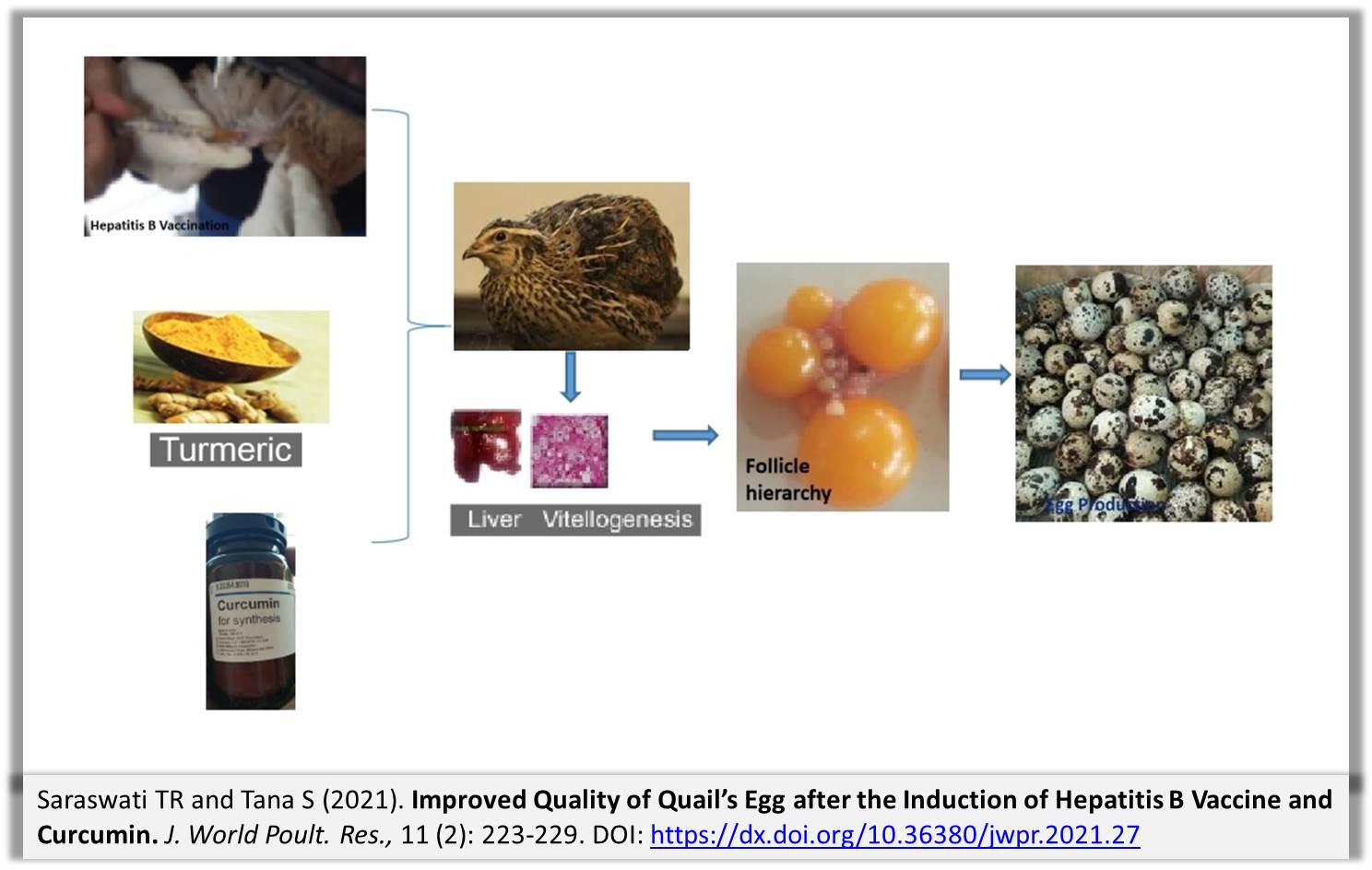 DOI: https://dx.doi.org/10.36380/jwpr.2021.27
DOI: https://dx.doi.org/10.36380/jwpr.2021.27
|
|
ABSTRACT: The present study aimed to observe the quality of quails’ eggs after being vaccinated with hepatitis B vaccine and given supplements of curcumin and turmeric powder. A total of 36 female quails at the age of 10 days were divided into four groups, including the control (P0), vaccinated with hepatitis B vaccine (P1), vaccinated with hepatitis B vaccine and given 12 mg/quail/day of supplement curcumin (P2), and vaccinated with hepatitis B vaccine and given 108 mg/quail/day of supplement turmeric powder (P3). Vaccination was given twice, at the age of 32 and 60 days. The curcumin and turmeric powder were given every day until the age of three months. The results showed significantly different outcomes on glutamic pyruvate transaminase serum, glutamic oxaloacetic transaminase serum, egg production (percentage of carbohydrates, protein, fat, cholesterol), and the physical quality of eggs, but it was not significantly different towards the liver weight. It can be concluded that quails vaccinated with hepatitis B vaccine and treated with supplements of curcumin and turmeric powder could improve liver function and increase egg production with better chemical and physical qualities.
Keywords: Curcumin, Egg, Follicle hierarchy, Liver function, Quail
[Full text-PDF] [XML] [Crossref Metadata] [Scopus ID: 85110498669] [Export from ePrint] [How to Cite]
Research Paper
The Estimation of Genetic Parameters for Body Weight, Body Dimension, and Carcass Traits in Four Egyptian Chickens Strains
El-Attrouny MM, Iraqi MM, and Mohamed ShA-H.
J. World Poult. Res. 11(2): 230-240, 2021; pii: S2322455X2100028-11
DOI: https://dx.doi.org/10.36380/jwpr.2021.28
|
|
ABSTRACT: Body weight and carcass traits are important traits in the poultry industry. Breeding programs are powerful strategies to improve these economic traits. The challenge, however, is to choose an appropriate strategy to increase production. The estimation of genetic parameters in target strains could provide valuable information to determine the potent breeding strategy. Therefore, the aim of the current study was to assess the heritability and the genetic correlations of the Body Weight (BW), Body Dimensions (BD), and Carcass Traits (CT) in four Egyptian strains (Matrouh, Mandarah, Inshas, and Silver Montazah) of dual-purpose chickens. The BW was measured at hatching (BW0), 8 weeks (BW8), and 16 weeks (BW16) of age, and weight gain was calculated from 8 to 16 weeks of age. The BD traits included shank length (SL), keel length (KL), and Body Circumference (BC). Carcass, liver, gizzard, heart, head, and leg percentages were also determined. Data were collected on 2800 dual-purpose chickens with pedigree information. A Multitrait animal model with a restricted maximum likelihood procedure was applied to estimate heritability, genetic and phenotypic correlations for BW, BD, and CT using Wombat software. Heritability estimates for BW traits were between 0.24 and 0.41 for BW0 and BW8, respectively. Heritability estimates of SL, KL, and BC were 0.49, 0.41, and 0.52, respectively. The heritability estimates for CT were low to moderate, ranging from 0.15 to 0.37 for head and gizzard percentage, respectively. The least-square means for BW, BD, and CT varied significantly between strains. The genetic correlation estimates among BW and BD traits indicated a close genetic relationship between these traits. Positive genetic correlations were found between BW and BD with CT (from 0.12 to 0.78). Based on the present results, there were strong positive genetic correlations between all traits, including BW and BD as the most important ones. Therefore, the selection for these traits would improve the carcass traits in the four strains of chickens. Hence, the inclusion of BW and BD as selection criteria in breeding programs would potently affect the improvement in carcass performance, which might positively increase the production profit of such strains.
Keywords: Body dimensions, Carcass, Egyptian strains, Genetic parameters, Heritability
[Full text-PDF] [XML] [Crossref Metadata] [Scopus ID: 85110462155] [Export from ePrint] [How to Cite]
Research Paper
Biochemical Properties and Cell Culture Affinity of Fowl Adenovirus Serotype-4 Strains Isolated from the Oviducts of Layer Hens in East Japan
Del Valle FP, Camba ShI, Umali DV, Sasai K, Shirota K, and Katoh H.
J. World Poult. Res. 11(2): 241-251, 2021; pii: S2322455X2100029-11
DOI: https://dx.doi.org/10.36380/jwpr.2021.29
|
|
ABSTRACT: In the present study, the biochemical properties of two fowl adenovirus serotype-4 (FAdV4) sample strains were determined. These were previously isolated from the oviducts of laying chickens from two layer operations in East Japan, namely M and Y farms. Tests for stability and sensitivity, hemagglutinating (HA) activity, and growth in two different cell lines were performed. The results showed that the M farm strain, (Japan/Ibaraki/M-HB2/2016) was sensitive to 100% ethanol, 52°C and higher temperature, and formaldehyde. The Y farm strain (Japan/Ibaraki/Y-H6/2016) was sensitive to 70% ethanol, 100% ethanol, 52°C and higher temperature, and formaldehyde. Both strains were stable against ether and chloroform, and lacked HA activity. To the best of the author’s knowledge, these FAdV4 strains were the first to be detected and isolated from laying chicken’s oviduct. Their biochemical characteristics; specifically, sensitivy to heat and formaldehyde, can be included in farm cleanup and disinfection protocol. This could help in reducing environmental contamination. The strains propagated well in chick embryo fibroblast (CEF) as indicated by cytopathic effect (CPE) observation with positive AAV-PCR and FAdV4-PCR results. The strains failed to propagate in MDCC-MSB1 cells as indicated by the negative results in both CPE and PCR. It appears that MDCC-MSB1 cells are not suitable for FAdV4 cultivation. However, only non-pathogenic FAdV4 strains were used in this work. It was not confirmed if pathogenic strains have the same behavior, perhaps, further trials are advisable. Future studies may benefit from the reduction of use of primary cells from live animals. This information contributes to the current understanding of FAdV4 characteristics.
Keywords: Biochemical properties, Cell culture, Fowl adenovirus serotype 4, Laying hen, Oviduct.
[Full text-PDF] [XML] [Crossref Metadata] [Scopus ID: 85110456595] [Export from ePrint] [How to Cite]
Research Paper
The Influence of Germinated Grain Mix on the Quality of Extruded Fodder
Matyushev V.V., Chaplygina I.A., Semenov A.V., and Belyakov A.A.
J. World Poult. Res. 11(2): 252-258, 2021; pii: S2322455X2100030-11
DOI: https://dx.doi.org/10.36380/jwpr.2021.30
|
|
ABSTRACT: The main factor in the development of modern animal husbandry is the development of methods for preparing feed for animals and enhancement of their nutritional value. To obtain high-energy feed, there is a need to use the germinated grain as one of the components for the extrusion used in animal food processing. The quality assessment of the extruded feed in terms of environmental and energy indicators based on a two-component mixture is of particular interest. In this regard, the purpose of the present research was to identify the regularities of changes in metabolic energy and the ecological-energy indicator of the feed quality, depending on the quantitative and qualitative content of the germinated component included in the extruded mixture. Wheat was mixed for 72 hours with pre-germinated grains of wheat, rapeseed, peas, oats, soybeans, or corn. The resulting mixture was extruded at a temperature of 120-130°C and pressure of 4-5 MPa. The highest metabolic energy of the feed was found in the extruded mixture containing 25% sprouted grains of soybeans, rapeseed, corn, peas, oats 15%, and wheat 10%. Regarding energy indicators, it is advisable to use 25% of the sprouted grain of soybeans, rapeseed, corn, peas, 15% of oats, and 10% of wheat in the extruded mixture as well as 10% of sprouted wheat, 25% peas, 25% corn, 10% soybeans, 20% oats, and 10% rapeseed. Based on the obtained results, a mathematical model was designed using the theory of splines. The modeling was carried out in the Maple package.
Keywords: Extrusion, Feed, Grain, Germination, Mix
[Full text-PDF] [XML] [Crossref Metadata] [Scopus ID: ] [ePub] [Export from ePrint] [How to Cite]
Review
Toxicological Effects of Diclofenac Sodium in Duodenum Tissue and Intestinal Microorganisms of Chickens
Li Zh, Lin Sh, Sun Ch, Huang Zh, Liu H, Wang K, Zhu T, Yin B, and Wan R.
J. World Poult. Res. 11(2): 259-270, 2021; pii: S2322455X2100031-11
DOI: https://dx.doi.org/10.36380/jwpr.2021.31
|
|
ABSTRACT: iclofenac sodium is a non-steroidal anti-inflammatory drug. After accidental exposure via food-chain of vultures feeding on livestock carcasses containing Diclofenac sodium residues leading to massive mortalities in vultures, its toxicity to avian has received widespread attention. In the present study, toxicity models of Diclofenac sodium to 30 specific-pathogen-free chickens aged 30 days were established through oral doses of 10 and 20 mg/kg, and its toxicological effects in duodenum tissues and intestinal microorganism of the chickens were explored. The results showed that Diclofenac sodium increased the content of uric acid, but decreased the activity of Xanthine oxidase indicating that its toxicity was more due to the obstruction of the urate excretion. Urate deposited in duodenum tissues induced the expression of nuclear factor erythroid-2 related factor, fas ligand, tumor necrosis factor-α, and tumor necrosis factor receptor superfamily member 1A, and caused severe edema, bleeding, villi shown broken and fallen off. In addition, after oral administration of Diclofenac sodium, the relative abundance of Proteobacteria and Bacteroidetes significantly increased while the relative abundance of Lactobacillales decreased. Diclofenac sodium disturbed the steady state of the intestinal environment leading to the proliferation of pathogenic bacteria but reduced the abundance of beneficial bacteria. The current research gave the toxicity evidence of Diclofenac sodium in duodenal tissue and intestinal microorganism.
Keywords: Chicken, Diclofenac sodium, Duodenum, Intestinal microorganism, Toxicity
[Full text-PDF] [XML] [Crossref Metadata] [Scopus ID: 85116432070] [Export from ePrint] [How to Cite]
Research Paper
Erythroplastids of Duck Blood Produced by Cytokinesis, Lysis, and Amitosis
Cotter PF.
J. World Poult. Res. 11(2): 271-277, 2021; pii: S2322455X2100032-11
DOI: https://dx.doi.org/10.36380/jwpr.2021.32
|
|
ABSTRACT: The aim is to describe anuclear erythrocytes (erythroplastids), pyrenocytes (small nucleated daughter erythrocytes), and amitosis (division without chromosomes or a spindle apparatus) of the commercial duck. Wright-Giemsa-stained blood samples came from ducks between 2 and 22 weeks of age. The erythroplastids and pyrenocytes were produced by fully hemoglobinized (normochromic) erythrocytes, and their earlier developmental stages (polychromatic erythrocytes). The cytokinesis results indicated a process beginning with constriction of the cell membrane, and continuing with constriction of the nucleus; followed by its polar displacement and expulsion. Instances of intermediate stages in which both the erythroplastid and the pyrenocyte remained attached by a thin cytoplasmic isthmus were also found. Erythroplastids may be produced by a second mechanism where the RBC nucleus lyses rather than being expelled. Furthermore, there were examples of erythroplastids produced during amitosis, occurring in mature erythrocytes, and at earlier (polychromatic) stages. The causes of erythroplastid formation and amitosis remain obscure, and it is possible that they result from distinct stimuli. As Goncalves et al. (2020) reported, recently erythroplastids were used to measure the effects of air pollution in passerine birds. However, as is the case for other atypical erythrocytes they could be the consequence of toxins, DNA damage, vitamin deficiencies, or immune dysfunction. Erythroplastids and amitotic cells were present along with evidence of fungal infection in some ducks and in others deliberately exposed to aflatoxin B1 supporting a case for toxicity. Accordingly, these atypical cells may serve as sensitive cytological indicators and bio-markers useful in the study of diseases or toxin exposure.
Keywords: Amitosis, Bio-marker, Erythroplastid, Mycotoxin, Pyrenocyte
[Full text-PDF] [XML] [Crossref Metadata] [Scopus ID: 85116488150] [Export from ePrint] [How to Cite]
Previous issue | Next issue | Archive
![]() This work is licensed under a Creative Commons Attribution 4.0 International License (CC BY 4.0).
This work is licensed under a Creative Commons Attribution 4.0 International License (CC BY 4.0).

